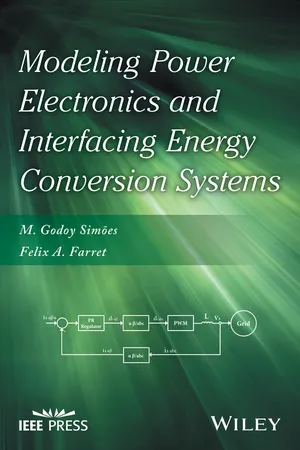
Modeling Power Electronics and Interfacing Energy Conversion Systems
M. Godoy Simoes, Felix A. Farret
- English
- ePUB (mobile friendly)
- Available on iOS & Android
Modeling Power Electronics and Interfacing Energy Conversion Systems
M. Godoy Simoes, Felix A. Farret
About This Book
Discusses the application of mathematical and engineering tools for modeling, simulation and control oriented for energy systems, power electronics and renewable energy
This book builds on the background knowledge of electrical circuits, control of dc/dc converters and inverters, energy conversion and power electronics. The book shows readers how to apply computational methods for multi-domain simulation of energy systems and power electronics engineering problems. Each chapter has a brief introduction on the theoretical background, a description of the problems to be solved, and objectives to be achieved. Block diagrams, electrical circuits, mathematical analysis or computer code are covered. Each chapter concludes with discussions on what should be learned, suggestions for further studies and even some experimental work.
- Discusses the mathematical formulation of system equations for energy systems and power electronics aiming state-space and circuit oriented simulations
- Studies the interactions between MATLAB and Simulink models and functions with real-world implementation using microprocessors and microcontrollers
- Presents numerical integration techniques, transfer-function modeling, harmonic analysis and power quality performance assessment
- Examines existing software such as, MATLAB/Simulink, Power Systems Toolbox and PSIM to simulate power electronic circuits including the use of renewable energy sources such as wind and solar sources
The simulation files are available for readers who register with the Google Group: power-electronics-interfacing-energy-conversion-systems@googlegroups.com. After your registration you will receive information in how to access the simulation files, the Google Group can also be used to communicate with other registered readers of this book.
Frequently asked questions
Information
1
INTRODUCTION TO ELECTRICAL ENGINEERING SIMULATION
- Balance equations, for stored masses, energies, and impulses
- Physical–chemical constitutive equations
- Phenomenological equations of irreversible processes (thermal conductivity, diffusion, chemical reaction)
- Entropy balance equations, if several irreversible processes are interrelated
- Connection equations, describing the interconnection of process elements
